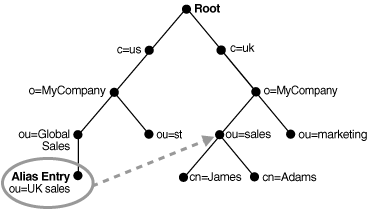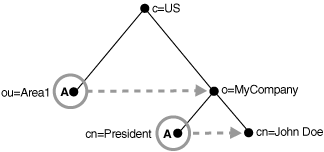18 Managing Alias Entries
This chapter includes the following sections:
For more information about attribute aliases, see Understanding Attribute Aliases.
Introduction to Alias Entries
Entries sometimes have distinguished names that are long and cumbersome. Oracle Internet Directory makes it easier to administer long names by using alias objects. When someone looks up—that is, references—an object by using an alias, the alias is dereferenced, and what is returned is the object to which the alias points.
For example, the alias, Server1, can be dereferenced so that it points to the fully qualified DN namely, dc=server1,dc=us,dc=myCompany,dc=com. This feature also enables you to devise structures that are not strictly hierarchical.
An alias entry uses the object class alias to distinguish it from object entries in a directory. The definition of that object class is as follows:
(2.5.6.1 NAME 'alias' SUP top STRUCTURAL MUST aliasedObjectName)
An alias entry also contains the aliasedObjectName attribute that, in turn, contains the DN of the object to which it is pointing. The definition of that attribute is as follows:
(2.4.5.1 NAME 'aliasedObjectName" EQUALITY distinguishedNmameMatch SYNTAX 1.3.6.1.4.1.1466.115.121.1.12 SINGLE-VALUE)
Note:
The aliasedObjectName attribute should not refer to the Directory Information Tree (DIT) view DN.
Figure 18-1 and the accompanying text provides an example of alias entry dereferencing.
Figure 18-1 Alias Entries Example

In Figure 18-1, ou=uk sales,ou=global sales,o=myCompany,c=us is an alias entry pointing to the ou=sales,o=myCompany,c=uk entry.
When anyone references ou=uk sales,ou=global sales,o=oracle,c=us, the directory server automatically reroutes them to the real entry, ou=sales,o=oracle,c=uk.
Adding an Alias Entry
To add an alias entry, you create a normal entry in LDIF and an alias entry pointing to the real entry.
Following the steps in this example produces the tree in Figure 18-2.
Figure 18-2 Resulting Tree when Creating the My_file.ldif

Description of "Figure 18-2 Resulting Tree when Creating the My_file.ldif"
In Figure 18-2, the letter A represents an alias entry, where:
-
ou=Area1is an alias pointing too=MyCompany -
cn=Presidentis an alias pointing tocn=John Doe
Searching the Directory with Alias Entries
You can search the base, one-level down the base, and a subtree by using flags.
The following sections explain this further:
Flags for Searching the Directory with Alias Entries
In each search you specify, there are flags you can set. The search is performed based on the flag you specify.
See Table 18-1for directory search behaviour based on alias flags.
Table 18-1 Flags for Searching the Directory with Alias Entries
| Flag | Search Behavior of LDAP Server |
|---|---|
|
|
Never dereferences aliases. |
|
|
Dereferences the base object in a search, but does not dereference alias entries that are under the base. |
|
|
Dereferences aliases in subordinates of the base object in search but not in locating the base object of the search. |
|
|
Dereferences aliases both in searching and in locating the base object of the search. |
By default, the dereference flag in ldapsearch is -a never and thus the directory server does not perform any dereferencing for alias entries.
Searching the Base with Alias Entries
A base search finds the top level of the alias entry you specify.
The following sections explain this further:
Searching the Base with Dereferencing Flag -a find
This example shows a base search of ou=Area1,c=us with a filter of "objectclass=*" with the dereferencing flag set to -a find.
ldapsearch -p port -h host -b "ou=Area1,c=us" -a find -s base "objectclass=*"
The directory server, during the base search, looks up the base specified in the search request and returns it to the user. However, if the base is an alias entry and, as in the example, -a find is specified in the search request, then the directory server automatically dereferences the alias entry and returns the entry it points to. In this example, the search dereferences ou=Area1,c=us, which is an alias entry, and returns o=MyCompany,c=us.
Searching the Base with Dereferencing Flag -a search
This example shows a base search of ou=Area1,c=us with a filter of "objectclass=*" with the dereferencing flag set to -a search.
ldapsearch -p port -h host -b "ou=Area1,c=us" -a search -s base "objectclass=*"
The directory server, during the base search, looks up the base specified in the search request and returns it to the user without dereferencing it. It returns ou=Area1,c=us.
Searching the Base with Dereferencing Flag -a always
This example shows a base search of ou=Area1,c=us with a filter of "objectclass=*" with the dereferencing flag set to -a always.
ldapsearch -p port -h host -b "ou=Area1,c=us" -a always -s base "objectclass=*"
The directory server, during the base search, looks up the base specified in the search request. If it is an alias entry, the directory server automatically dereferences the alias entry and returns the entry it points to. In this example, the search dereferences ou=Area1,c=us, which is an alias entry, and returns o=MyCompany,c=us.
Searching One-Level with Alias Entries
A one-level search finds only the children of the base level you specify.
The following sections explain this further:
Searching One-Level with Dereferencing Flag -a find
This example shows a one-level search of "ou=Area1,c=us" with a filter of "objectclass=*" with the dereferencing flag set to -a find.
ldapsearch -p port -h host -b "ou=Area1,c=us" -a find -s one "objectclass=*"
The directory server returns one-level entries under the base that match the filter criteria. In the example, -a find is specified in the search request, and thus the directory server automatically dereferences while looking up the base (the first step), but does not dereference alias entries that are one level under the base. Therefore, the search dereferences ou=Area1,c=us, which is an alias entry, and then looks up one-level entries under o=MyCompany,c=us. One of the one-level entries is cn=President,o=MyCompany,c=us that is not dereferenced and is returned as is.
Thus, the search returns cn=President,o=MyCompany,c=us and cn=John Doe,o=MyCompany,c=us.
Searching One-Level with Dereferencing Flag -a search
This example shows a one-level search of "ou=Area1,c=us" with a filter of "objectclass=*" with the dereferencing flag set to -a search.
ldapsearch -p port -h host -b "ou=Area1,c=us" -a search -s one "objectclass=*"
The directory server searches for the base that is specified in the search request. If the base entry is an alias entry, it returns nothing. (Alias entries cannot have children.) Otherwise, it returns the base entry's immediate children after dereferencing them. In this example, the base entry is "ou=Area1,c=us", which is an alias entry, so the search returns nothing
Searching One-Level with Dereferencing Flag -a always
This example shows a one-level search of "ou=Area1,c=us" with a filter of "objectclass=*" with the dereferencing flag set to -a always.
ldapsearch -p port -h host -b "ou=Area1,c=us" -a always -s one "objectclass=*"
In the example, -a always is specified in the search request, and thus the directory server automatically dereferences while looking up the base (the first step), then dereference alias entries that are one level under the base. Therefore, the search dereferences ou=Area1,c=us, which is an alias entry, and then looks up one-level entries under o=MyCompany,c=us. One of the one-level entries is cn=President,o=MyCompany,c=us. That is dereferenced and is returned as cn=John Doe,o=MyCompany,c=us. The other one-level entry is cn=John Doe,o=MyCompany,c=us, which has already been returned.
Thus, the search returns cn=John Doe,o=MyCompany,c=us.
Searching a Subtree with Alias Entries
A subtree search finds the base, children, and grand children.
The following sections explain this further:
Searching Subtree with Dereferencing Flag -a find
This example shows a subtree search of "ou=Area1,c=us" with a filter of "objectclass=*" with the dereferencing flag set to -a find.
ldapsearch -p port -h host -b "ou=Area1,c=us" -a find -s sub "objectclass=*"
The directory server returns all entries under the base that match the filter criteria. In the example, -a find is specified in the search request, and thus the directory server automatically dereferences while looking up the base (the first step), but does not dereference alias entries that are under the base. Therefore, the search dereferences ou=Area1,c=us, which is an alias entry, and then looks up entries under o=MyCompany,c=us. One of the entries is cn=President,o=MyCompany,c=us that is not dereferenced and is returned as is.
Thus, the search returns:
-
o=MyCompany,c=us -
cn=John doe,o=MyCompany,c=us -
cn=President,o=MyCompany,c=us
Searching Subtree with Dereferencing Flag -a search
This example shows a subtree search of "ou=Area1,c=us" with a filter of "objectclass=*" with the dereferencing flag set to -a search.
ldapsearch -p port -h host -b "ou=Area1,c=us" -a search -s sub "objectclass=*"
The directory searches for the base that is specified in the search request.If the base is an alias entry, then it returns the base entry without dereferencing it. (Alias entries cannot have children.) Otherwise it returns all entries under the base. If any alias entries are found, it dereferences them and returns all entries under them as well.
In this example, the base entry is an alias entry, ou=Area1,c=us, so the directory returns ou=Area1,c=us.
Searching Subtree with Dereferencing Flag -a always
This example shows a subtree search of "ou=Area1,c=us" with a filter of "objectclass=*" with the dereferencing flag set to -a always.
ldapsearch -p port -h host -b "ou=Area1,c=us" -a always -s sub "objectclass=*"
The directory server dereferences the base entry and returns it. It also returns all entries under the dereferenced base. If any alias entries are found, it dereferences them and returns all entries under them as well.
In this example, the base entry is ou=Area1,c=us, which is dereferenced to o=MyCompany,c=us, which is returned. There are two entries under o=MyCompany,c=us. One is cn=President,o=MyCompany,c=us, which is returned and also dereferenced to cn=John Doe,o=MyCompany,c=us, which is returned. The other entry under o=MyCompany,c=us, which has already been returned. So the result is o=MyCompany,c=us and cn=John Doe,o=MyCompany,c=us.
Modifying Alias Entries
You can modify alias entries using ldapmodify command.
This example shows how to modify alias entries. It creates a sample LDIF file, My_file.ldif with following entries:
dn: cn=President, o=MyCompany, c=us changetype : modify replace: aliasedobjectname aliasedobjectname: cn=XYZ, o=MyCompany, c=us
Modify the alias entry using the following command:
ldapmodify -D "cn=orcladmin" -q -p port -h host -f My_file.ldif
Messages Related to Alias Dereferencing
A dereferencing message is displayed when there is a problem associated with aliases.
Table 18-2 lists the messages related to alias entry dereferencing and the corresponding meaning for each message.
Table 18-2 Entry Alias Dereferencing Messages
| Message | Meaning |
|---|---|
|
Alias Problem |
Either of the following have occurred:
|
|
Alias Dereferencing Problem |
The user cannot dereference an alias because of access control issues. |
|
No Such Object |
The server cannot find the base DN specified in the search request. |
|
Invalid DN Syntax |
When adding or modifying an alias entry, if the value specified for |
|
Success |
The client operation successfully completes. When the dereferenced target does exist but does not match the filter specified in the search request, the server returns a success message with no matched entry. |
|
Insufficient Access Rights |
The user does not have access to the dereferenced entry. |